Divya Desam
A Divya Desam or Vaishnava Divya Desam[1] is one of the 108 Vishnu temples that are mentioned in the works of the Alvars (saints). ”Divya” means “divine” and “Desam” indicates “place of abode” (temple).[2] Of the 108 temples, 105 are in India, one is in Nepal, and the last two are believed to be outside the Earthly realms. In India, they are spread over states of Tamil Nadu (85), Kerala (11), Andhra Pradesh (2), Gujarat (1), Uttar Pradesh (4), Uttarakhand (3). Muktinath, Saligramam is the only Divya Desam in Nepal. The Divya Desams are revered by the 12 Alvars in the Divya Prabandha, a collection of 4,000 Tamil verses. Divya Desams follow Thenkalai or Vadakalai modes of worship.[3]
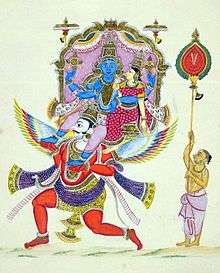
Etymology
In Divya desam, Divya means "premium" or "divine" and Desam indicates "place" (temple).
Alvars and Divyaprabhanda
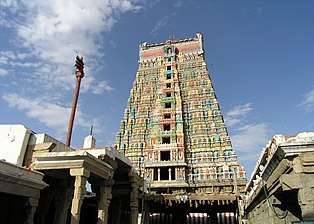
The word azhwar in Tamil, means one who immerses oneself into the ocean of the countless attributes of god. Azhwars are considered the twelve supreme devotees of Vishnu, who were instrumental in popularising Vaishnavism during the 5th-8th centuries AD. The religious works of these saints in Tamil, songs of love and devotion, are compiled as Nalayira Divya Prabandham containing 4000 verses and the 108 temples revered in their songs are classified as Divya desam.[4][5] The saints had different origins and belonged to different castes. As per tradition, the first three azhwars(mudhal azhwargal ), Poigai, Bhutha and Pey were said to be born out of divinity. According to tradition, Tirumazhisai was the son of a sage, Thondaradi, Mathurakavi, Peria and Andal were from brahmin community, Kulasekhara from Kshatria community, Namm was from a cultivator family, Tirupana from panar community and Tirumangai from kalvar community.
Divya Suri Saritra by Garuda-Vahana Pandita (11th century AD), Guruparamparaprabhavam by Pinbaragiya Perumal Jeeyar, Periya tiru mudi adaivu by Anbillai Kandadiappan, Yatindra Pranava Prabavam by Pillai Lokacharya, commentaries on Divya Prabandam, Guru Parampara (lineage of Gurus) texts, temple records and inscriptions give a detailed account of the azhwars and their works. According to these texts, the saints were considered incarnations of some form of Vishnu. Poigai is considered an incarnation of Panchajanya (Krishna's conch), Bhoothath of Kaumodakee (Vishnu's Mace/Club), Pey of Nandaka (Vishnu's sword), Thirumalisai of Sudarshanam (Vishnu's discus), Namm of Vishvaksena (Vishnu's commander), Madhurakavi of Vainatheya (Vishnu's eagle, Garuda), Kulasekhara of Kaustubha (Vishnu's necklace), Periy of Garuda (Vishnu's eagle), Andal of Bhoodevi (Vishnu's wife, Lakshmi, in her form as Bhudevi), Thondaradippodi of Vanamaalai (Vishnu's garland), Thiruppaan of Srivatsa[6] (An auspicious mark on Vishnu's chest) and Thirumangai of Sarangam (Krishna's bow). The songs of Prabandam are regularly sung in all the Vishnu temples of South India daily and also during festivals.[5][7]
Significance of Divya Desams
In Hindu texts, these temples are often referred to as Bhooloka Vaikuntam, which in Sanskrit means Heaven on earth.[8] Each of the Divya Desam has its own significance related to Shri Vaishnava Mythology. Each of these Temples had separate shrines for Maha Vishnu and Maha Lakshmi.[1]
List of Divya Desams
The 106 earthly Divya Desam temples are spread over the Indian states of Tamil Nadu (85), Kerala (11), Uttar Pradesh (4), Uttarakhand (3), Andhra Pradesh (2) and Gujarat (1), and Country of Nepal(1)- Muktinath. The last two are believed to be outside earthly realms.
| S.No. | Name of the temple | Location | Photo | Presiding deity | Notes/Beliefs |
|---|---|---|---|---|---|
| 1 | Ranganathaswamy Temple, Srirangam | Srirangam, Trichy district Tamil Nadu 10.8625°N 78.689722°E |
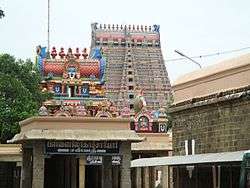 |
Sri Ranganayaki sametha Sri Ranganatha Perumal | Srirangam temple is often listed as the largest functioning Hindu temple in the world, the still larger Angkor Wat being the largest existing temple. The temple occupies an area of 156 acres (631,000 m²) with a perimeter of 4,116m (10,710 feet) making it the largest temple in India and one of the largest religious complexes in the world.[9][10] The annual 21 day festival conducted during the Tamil month of Margazhi (December–January) attracts 1 million visitors.[11] |
| 2 | Thirukozhi | Uraiyur, Trichy district Tamil Nadu 10.82°N 78.67°E |
 |
Sri Kamalavalli sametha Sri Azhagiya Manavala Perumal |
The temple locally called Nachiyar Koil and is one of the few Divyadesams where the goddess has prominence over Vishnu.[12][13]The temple is the birthplace of Thiruppaan Alvar, one of the twelve Azhwar saints belonging to the 6th-8th centuries. In Srirangam, the yearly birth festival of Tirupannazhwar is celebrated with Viswaroopa darshan of Ranganatha at the sanctum on the occasion of his birthday. The festive idol of Tiupannazhwar is taken from the temple to Srirangam.[14] |
| 3 | Thirukkarambanoor | Uthamarkoil, Tiruchirappalli district Tamil Nadu 10.49°N 78.81°E |
 |
Sri Purushottama Nayaki sametha Sri Purushottama Perumal | The temple is only a few of the temples that are dedicated to the Hindu god Trimurti (trinity) namely Vishnu, Shiva and Brahma. As per Hindu legend, the temple is believed to have been constructed by Janakar, the king of Janakapuri and the father of Sita from the epic Ramayana. Thirumangai Azhwar is believed to have resided in the temple to build the surrounding walls of the Srirangam Ranganathaswamy temple.[15] |
| 4 | Pundarikakshan Perumal Koil | Thiruvellarai, Trichy district Tamil Nadu 10.96°N 78.67°E |
 |
Sri Pankaja Nayaki sametha Sri Pundarikaksha Perumal |
Pundarikakshan Perumal temple is believed to have been built by the Pallava king Dantivarman (796–847 AD).[16][17]A swastika-shaped temple tank built during 800 AD is present in the south-western corner of the street around the temple. It has four stepped gateways, each having 51 steps. The tank is believed to have been built by Kamban Araiyan during the reign of Dantivarman. In modern times, it is maintained by the Department of Archaeology of the Government of Tamil Nadu. The temple complex covers an area of 2.62 ha (6.5 acres), while the tank covers an area of 0.1256 ha (0.310 acres).[18][19]The chariot festival is unique in the state as a community feast is offered by several individuals and committees, a custom many centuries old.[20][21] |
| 5 | Vadivazhagiya Nambi Perumal Koil | Anbil, Trichy district Tamil Nadu 10.867735°N 78.882171°E |
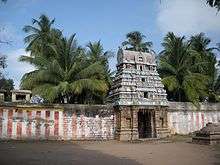 |
Sri Saundaryavalli sametha Sri Sundararaja Perumal | King Sundara Chola who ruled the area was a devotee of the temple and during each of his innumerable victories in wars, he showered a lot of wealth on this temple. His prime minister Anirudha Brahmarayar is believed to be from Anbil, the village where the temple is located. The copper plates having the records from the Chola period from Anbil indicate generous contribution from the Medieval Cholas indicate various gifts to the temple.[22][23] |
| 6 | Appakkudathaan Perumal Koil | Koviladi, Tanjore district Tamil Nadu 10.839307°N 78.889073°E |
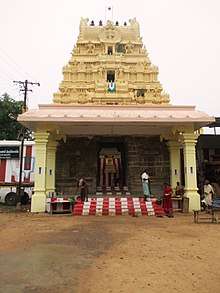 |
Sri Indravalli sametha Sri Appakudatthan Perumal | The temple has inscriptions from the 18th year of the reign of Aditya Chola.[24][25] The temple is one of the five Pancharanga Kshetrams, a group of five Hindu temples on the banks of the Kaveri River dedicated to Ranganatha, a form of Vishnu.[26][27] |
| 7 | Hara Saabha Vimocchana Perumal Temple | Kandiyur, Thanjavur district Tamil Nadu 10.860255°N 79.108891°E |
 |
Sri Kamalavalli sametha Sri Hara Saabha Vimochana Perumal |
Since Vishnu relieved (vimochana) the curse (saabha) of Shiva (also called Hara), the temple is called Hara Saabha Vimochana Temple.[28] |
| 8 | Thirukoodalur | Aduthurai, Thanjavur district, Tamil Nadu 10.925152°N 79.203532°E |
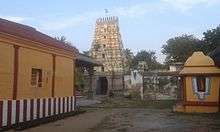 |
Sri Padmasani sametha Sri Jagathrakshaga Perumal | Kaveri wanted to cleanse herself and approached Hindu god Brahma. She is believed to have worshipped Vishnu at this place and got relieved. A parrot which was devoted to Vishnu was shot down in the nearby forest. Vishnu rescued the parrot and appeased him of his previous birth. Thus it is believed that Vishnu descends here for all forms of life. Vishnu is also believed to have appeared for sage Nandaka.[29] |
| 9 | Thirukavithalam | Kabisthalam , Thanjavur district, Tamil Nadu 10.946890°N 79.256512°E |
 |
Sri Ramamanivalli sametha Sri Gajendravarada Perumal | Gajendra Varadha is believed to have appeared to Gajendra the elephant also called Indrajumnan, the crocodile called Huhu, Sage Parasara and Sri Anjaneya.[30] The temple is one of the Panchakanna (Krishnaranya) Kshetrams, the five holy temples associated with Krishna, an avatar of Vishnu.[31][32] |
| 10 | Thiruppullamboothangudi | Pullabhoothangudi , Thanjavur district, Tamil Nadu 10.971596°N 79.303415°E |
.jpg) |
Sri Hemambujavalli sametha Sri Rama Perumal | Kolavalli Ramar is believed to have appeared for Sita and the temple is believed to be the place where Rama performed the last rites of the eagle king Jatayu.[33] |
| 11 | Thiruaadhanur | Adanur, Thanjavur district, Tamil Nadu 10.976470°N 79.313454°E |
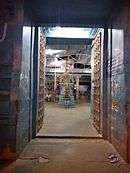 |
Sri Ranganayaki Thayar sametha Sri Andalukkum Aiyyan Perumal | Andalakkum Aiyarn is believed to have appeared for an affluent devotee trying to save Rangantha. [34] It is also believed that the presiding deity appeared for Kamadhenu, the holy cow and also for Thirumangai Azhwar, the saint poet of 8th century.[35] |
| 12 | Thirukudanthai | Kumbakonam, Thanjavur district, Tamil Nadu 10.959649°N 79.374999°E |
Sri Komalavalli sametha Sri Aravamuda Perumal | The temple is called Ubaya Pradhana Kshetram as the Moolavar (presiding deity) and utsavar (festive deity) enjoy the same importance.It is believed that the presiding deity asked Nathamuni to compile the four thousand verses of Nalayira Divya Prabandham at this place.[36] The twin temple chariots weigh 300 t (660,000 lb) each and are next only in size to the ones in Thygaraja temple in Thiruvarur and Andal Temple in Srivilliputhur.[37] This temple is along Kaveri and is one of the Pancharanga Kshetrams.[38] | |
| 13 | Thiruvinnagar | Tirunageswaram, Thanjavur district, Tamil Nadu 10.961570°N 79.432080°E |
Sri Bhumidevi sametha Sri Uppiliappan Perumal | It is believed that Vishnu appeared as Uppiliappan to marry sage Hemarishi's daughter who was Lakshmi's avatar. Since the sage quoted that her girl is too young that she doesnt even know how to cook with salt, Vishnu agreed to accept offering without salt.[39] | |
| 14 | Thirunaraiyur | Nachiyar Kovil, Thiruvarur district, Tamil Nadu 10.915844°N 79.445554°E |
.jpg) |
Sri Vanchulavalli sametha Sri Srinivasa Perumal | Vishnu was of the view that during Kali Yuga, men would have to listen to women. Hence he decided that he would first set an example and listen to the goddess here. During all festive occasions, the first rights are reserved for Nachiyar, who moves ahead, while Srinivasa follows her. Even the food is first served to Nachiyar and then to Srinivasa.[39] The Kal Garuda image in the temple used during the festive occasions is believed to increase in weight seeking 4, 8, 16, 32, 64 and 128 people in succession when the procession comes out of various gates from the sanctum to the main entrance of the temple.[40] |
| 15 | Thirucherai | Tirucherai, Thiruvarur district, Tamil Nadu 10.879135°N 79.454402°E |
.jpg) |
Sri Saranayaki sametha Sri Saranatha Perumal | Saranathan is believed to have appeared to river Cauvery, sage Markandeya and Hindu gods Indra. The crown of some of the images from the Chola period show influence of Buddhist tradition in the region.[41] The metal image of Sita is believed to be a classic example of Chola Art during the 9th-10th centuries.[42][43] |
| 16 | Thirunandhipura Vinnagaram | Nathan Kovil, Thiruvarur district, Tamil Nadu 10.922075°N 79.372192°E |
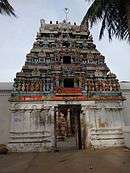 |
Sri Shenbagavalli sametha Sri Jagannatha Perumal | Nandi, the sacred bull of Shiva, is believed to have got his curses relieved by worshipping Vishnu here and hence the place is called Nandipuram and Nandhipura Vinnagaram. [44] It is also believed that king Sibi worshiped Vishnu at this place.[45] |
| 17 | Thiruvelliyangudi | Thiruvelliyangudi, Nagapattinam district, Tamil Nadu 11.056687°N 79.443095°E |
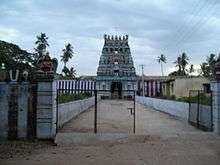 |
Sri Maragadhavalli sametha Sri Kolavilli Rama Perumal | The temple is counted as Vaishnava Sukra Kshetra as Vishnu appeared as a beautiful deity to please his devotee Sukra (Venus).[46] The place derived its name Thiruvelliyangudi hence and the presiding deity is also referred to as Velliyan. It is believed that Vishnu appeared in Kalyana Kolam (marriage posture) to Parasarar, Markendeyar, Mayan, Brahma, Sukran and Bhudevi. To de-stress or relieve Lord Vishnu, his mount or vahana, the eagle Garuda, holds the conch and the Sudarshana Chakram or discuss|wheel of Vishnu which is very unique in nature, making this the only temple where Garuda is depicted in such a posture.[47] |
| 18 | Thirukannamangai | Thirukannamangai, Nagapattinam district, Tamil Nadu 10.799552°N 79.586645°E |
Sri Abishekavalli sametha Sri Bhaktavatsala Perumal | The temple is one of the Panchakanna (Krishnaranya) Kshetrams, the five holy temples associated with Krishna, an avatar of Vishnu.[31][32] | |
| 19 | Thirukannapuram | Tirukannapuram, Nagapattinam district, Tamil Nadu 10.868499°N 79.704266°E |
Sri Kannapura Nayaki sametha Sri Sowriraja Perumal | The Lord here, has real silky hair that grows. Legend has it that he grew the hair to safeguard his devotee's words, that the idol in the temple has hair. The temple is one of the Panchakanna (Krishnaranya) Kshetrams, the five holy temples associated with Krishna, an avatar of Vishnu.[31][32] | |
| 20 | Thirukannangudi | Tirukannankudi, Nagapattinam district, Tamil Nadu 10.757222°N 79.763290°E |
Sri Loganayaki sametha Sri Lokanatha Perumal | The temple is one of the Panchakanna (Krishnaranya) Kshetrams, the five holy temples associated with Krishna, an avatar of Vishnu.[31][32] | |
| 21 | Thirunagai | Nagapattinam, Nagapattinam district, Tamil Nadu 10.759830°N 79.843706°E |
Sri Saundaryavalli sametha Sri Sundararaja Perumal | ||
| 22 | Thiruthanjai Mamanikoil | Thanjavur, Thanjavur district, Tamil Nadu 10.815669°N 79.138677°E |
Sri Raktapankajavalli sametha Sri Neelamegha Perumal |
Unlike other Divyadesams where a single shrine is referred, this set of temples is referred together in all the paasurams(poems). During the Treta Yuga, there were three demons by name Tanchakan, Tantakan and Kacamukan who were blessed by Shiva became very powerful. They grew arrogant and troubled sage Parashara who was doing penance at this place. Vishnu killed Thanjakan after whom Thanjavur was named, with his Chakra, Kachamukan by taking the form of a yali, a mythical creature and took the form of Varaha the boar to kill the third demon Tantakan, who feld to Srimushnam.[48] | |
| Manikundram | Thanjavur, Thanjavur district, Tamil Nadu 10.816923°N 79.137229°E |
Sri Ambujavalli sametha Sri Maniparvata Perumal | |||
| Thanjaiyali Nagar | Thanjavur, Thanjavur district, Tamil Nadu 10.816022°N 79.139155°E |
Sri Thanjanayaki sametha Sri Narasimha Perumal | |||
| 23 | Thiruvazhundur | Theranzhdur, Nagapattinam district, Tamil Nadu 11.046532°N 79.579468°E |
 |
Sri Senkamalavalli sametha Sri Devadiraja Perumal |
|
| 24 | Thiruchirupuliyur | Thirusirupuliyur, Nagapattinam district, Tamil Nadu 10.991202°N 79.669440°E |
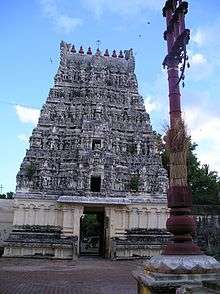 |
Sri Dayanayaki sametha Sri Krupasamudra Perumal | |
| 25 | Thiruthalaichanga Nanmadiyam | Thalachangadu, Nagapattinam district, Tamil Nadu 11.129789°N 79.785252°E |
.jpg) |
Sri Thalaichanga Nachiyar sametha Sri Chandrasaabahara Perumal | |
| 26 | Thiruindalur | Indalur, Nagapattinam district, Tamil Nadu 11.109733°N 79.646232°E |
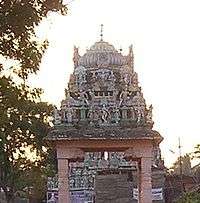 |
Sri Parimala Ranganayaki sametha Sri Parimala Ranganatha Perumal |
|
| 27 | Thirukazhicheerama Vinnagaram | Sirkazhi, Nagapattinam district, Tamil Nadu 11.07479°N 79.731704°E |
.jpg) |
Sri Lokanayaki sametha Sri Trivikrama Perumal | |
| 28 | Thirukkavalambadi | Thirunangur, Nagapattinam district, Tamil Nadu 11.1769°N 79.7824°E |
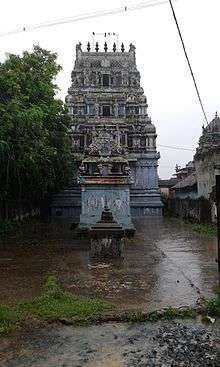 |
Sri Senkamala Nachiyar sametha Sri Gopala Krishna Perumal | |
| 29 | Thiruarimeya Vinnagaram | Thirunangur, Nagapattinam district, Tamil Nadu 11.17768°N 79.78152°E |
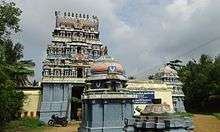 |
Sri Amrudhagadavalli sametha Sri Kudamudakoothan Perumal | |
| 30 | Thiruvanpurushothamam | Thirunangur, Nagapattinam district, Tamil Nadu 11.178783°N 79.776690°E |
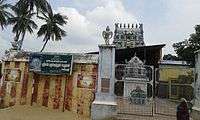 |
Sri Purushotthama Nayaki sametha Sri Purushottama Perumal | |
| 31 | Thirusemponsaikoil | Thirunangur, Nagapattinam district, Tamil Nadu 11.178446°N 79.779651°E |
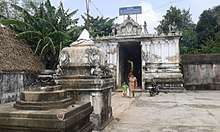 |
Sri Sweda Pushpavalli sametha Sri Hemaranganatha Perumal | |
| 32 | Thirumanimadakoil | Thirunangur, Nagapattinam district, Tamil Nadu 11.173971°N 79.776872°E |
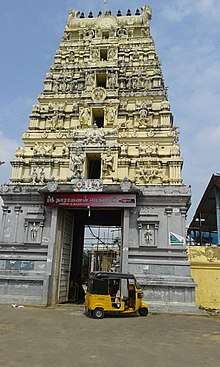 |
Sri Pundareegavalli sametha Sri Sashvatha Deepaya Narayana Perumal | |
| 33 | Thiruvaikunta Vinnagaram | Thirunangur, Nagapattinam district, Tamil Nadu 11.179804°N 79.778267°E |
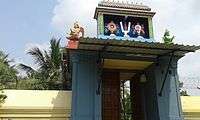 |
Sri Vaikundavalli sametha Sri Vaikundanatha Perumal | |
| 34 | Thiruthetriambalam | Thirunangur, Nagapattinam district, Tamil Nadu 11.17302°N 79.7951°E |
 |
Sri Rakthapankajavalli sametha Sri Lakshmiranga Perumal | |
| 35 | Thirumanikoodam | Thirunangur, Nagapattinam district, Tamil Nadu 11.177415°N 79.777838°E |
 |
Sri Boonayagi sametha Sri Varadharaja Perumal | |
| 36 | Thiruparthanpalli | Parthanpalli, Nagapattinam district, Tamil Nadu 11.169952°N 79.797515°E |
 |
Sri Tamarai Nayagi sametha Sri Taamaraiyaal Kelvan Perumal | |
| 37 | Thiruvali | Thiruvali, Nagapattinam district, Tamil Nadu 11.202979°N 79.774538°E |
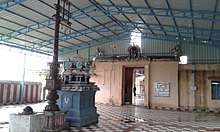 |
Sri Amrudhagadavalli sametha Sri Kedarapathivaraya Perumal | |
| Thirunagari | Thirunagari, Nagapattinam district, Tamil Nadu 11.226354°N 79.800335°E |
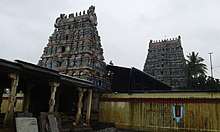 |
Sri Amurdha Valli sametha Sri Devaraja Perumal | ||
| 38 | Thiruthevanarthogai | Thirunangur, Nagapattinam district, Tamil Nadu 11.196842°N 79.775504°E |
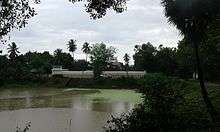 |
Sri Samudradanaya sametha Sri Devanayaka Perumal | |
| 39 | Thiruvellakulam | Thirunangur, Nagapattinam district, Tamil Nadu 11.190106°N 79.764929°E |
 |
Sri Padmavathi sametha Sri Srinivasa Perumal | |
| 40 | Thiruchitrakootam | Chidambaram, Cuddalore district, Tamil Nadu11.399207°N 79.693364°E |
%2C_Nataraja_Temple_-_panoramio.jpg) |
Sri Pundareekavalli sametha Sri Govindaraja Perumal | |
| 41 | Thiruvaheendrapuram | Thiruvanthipuram, Cuddalore district, Tamil Nadu11.745099°N 79.709351°E |
.jpg) |
Sri Hemambujavalli sametha Sri Devanatha Perumal | |
| 42 | Thirukkovalur | Thirukoyilur, Tiruvannamalai district, Tamil Nadu11.967006°N 79.202479°E |
Sri Pushpavalli sametha Sri Trivikrama Perumal | The temple is believed to be the place where the first three Azhwars, the Vaishnava saints, namely, Poigai Alvar, Bhoothathalvar and Peyalvar attained salvation. The temple is one of the Panchakanna (Krishnaranya) Kshetrams, the five holy temples associated with Krishna, an avatar of Vishnu.[31][32] | |
| 43 | Thirukkachi - Atthigiri | Kanchipuram, Kanchipuram district, Tamil Nadu12.819137°N 79.724646°E |
.jpg) |
Sri Perundevi sametha Sri Devadiraja Perumal | One of the greatest Hindu scholars of Vaishnava VisishtAdvaita philosophy, Ramanuja is believed to have resided in this temple.[49] The temple along with Ekambareswarar Temple and Kamakshi Amman Temple in Kanchipuram is popularly known as Mumurtivasam (abode of trio),[50] while Srirangam is referred to as ‘ The Koil’ (meaning: "temple") and Tirupati as the ‘Malai’ (Meaning: "hill"). |
| 44 | Ashtabuyagaram | Kanchipuram, Kanchipuram district, Tamil Nadu12.822736°N 79.710806°E |
.jpg) |
Sri Padmasani sametha Sri Ashtabhuja Perumal | The elephant Gajendra, used to worship Vishnu with the lotus fetched from the temple tank everyday. Once while picking up lotus, a crocodile caught the leg of Gajendra, who started calling the name of Vishnu for help. Vishnu sent his discus to punish the crocodile and relieve the elephant. The presiding deity is addressed by various names like Adikesava Perumal, Gajendra Varadhan and Chakradhar.[51] |
| 45 | Thiruthanka | Kanchipuram, Kanchipuram district, Tamil Nadu12.824382°N 79.705543°E |
 |
Sri Maragadhavalli sametha Sri Deepaprakasa Perumal | |
| 46 | Thiruvelukkai | Kanchipuram, Kanchipuram district, Tamil Nadu12.822197°N 79.706450°E |
.jpg) |
Sri Amritavalli sametha Sri Yoga Narasimha Perumal | Azhagiya Singar is believed to have appeared to slay Hiranya, the demon king. Velukkai is derived from Vel (desire) and irukkai (place of stay), meaning the place where Vishnu desired to stay, which became Velukkai from Velirukkai.[52] |
| 47 | Thiruneeragam | Kanchipuram, Kanchipuram district, Tamil Nadu12.839122°N 79.705185°E |
 |
Sri Nilamangai Valli sametha Sri Jagadeesha Perumal | |
| 48 | Thiruppadagam | Kanchipuram, Kanchipuram district, Tamil Nadu12.842726°N 79.696941°E |
.jpg) |
Sri Rukmani sametha Sri Pandavadootha Perumal | The temple is considered one of three oldest temples in Kanchipuram and is believed to have been built by the Pallavas of the late 8th century AD, with later contributions from Medieval Cholas and Vijayanagar kings. The temple is associated with a chapter in Mahabharata when Krishna went to the Kauravas as a missive (called Thoota locally) to the Pandavas.[53] |
| 49 | Nilathingal Thundam | Kanchipuram, Kanchipuram district, Tamil Nadu12.847463°N 79.699313°E |
 |
Sri Chandrasoodavalli sametha Sri Chandrasooda Perumal | |
| 50 | Thiruooragam | Kanchipuram, Kanchipuram district, Tamil Nadu12.839122°N 79.705185°E |
 |
Sri Amudavalli sametha Sri Trivikrama Perumal | |
| 51 | Thiruvekka | Kanchipuram, Kanchipuram district, Tamil Nadu12.824070°N 79.712462°E |
.jpg) |
Sri Komalavalli sametha Sri Yathottakari Perumal | |
| 52 | Thirukkaragam | Kanchipuram, Kanchipuram district, Tamil Nadu12.839122°N 79.705185°E |
 |
Sri Padmamani sametha Sri Karunagara Perumal | |
| 53 | Thirukkarvaanam | Kanchipuram, Kanchipuram district, Tamil Nadu12.839122°N 79.705185°E |
 |
Sri Kamalavalli sametha Sri Neelamega Perumal | |
| 54 | Thirukkalvanur | Kanchipuram, Kanchipuram district, Tamil Nadu12.840653°N 79.703250°E |
 |
Sri Anjilai Valli sametha Sri Adi Varaha Perumal | |
| 55 | Thiruppavalavannam | Kanchipuram, Kanchipuram district, Tamil Nadu12.843658°N 79.707604°E |
 |
Sri Pavalavalli sametha Sri Pavalavarna Perumal | |
| 56 | Thiru Parameswara Vinnagaram | Kanchipuram, Kanchipuram district, Tamil Nadu12.837151°N 79.709482°E |
Sri Vaikundavalli sametha Sri Vaikundanatha Perumal | ||
| 57 | Thiruputkuzhi | Thiruputkuzhi, Kanchipuram district, Tamil Nadu12.872642°N 79.618683°E |
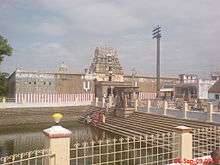 |
Sri Maragadhavalli sametha Sri Vijayaraghava Perumal | |
| 58 | Thirunindravur | Thirunindravur, Tiruvallur District, Tamil Nadu13.112501°N 80.026096°E |
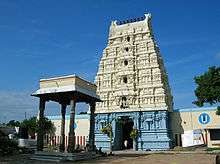 |
Sri Sudhavalli sametha Sri Bhaktavatsala Perumal | |
| 59 | Thiruvallur | Thiruvallur, Tiruvallur district, Tamil Nadu13.143204°N 79.907439°E |
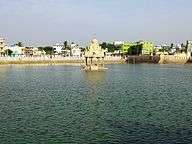 |
Sri Kanakavalli sametha Sri Vaidya Veeraraghava Perumal | |
| 60 | Thiruvallikeni | Chennai, Chennai district, Tamil Nadu13.053920°N 80.276942°E |
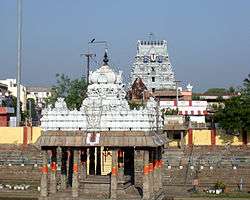 |
Sri Rukmini sametha Sri Venkatakrishna Perumal | The name Parthasarathy, in Tamil, means the 'charioteer of Arjuna', referring to Krishna's role as a charioteer to Arjuna in the epic Mahabaratha. It was originally built by the Pallavas in the 8th century and considered the oldest structural in Chennai.[54] |
| 61 | Thiruneermalai | Kanchipuram, Kanchipuram district, Tamil Nadu12.963808°N 80.114953°E |
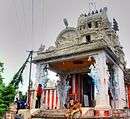 |
Sri Animamalar Mangai sametha Sri Neervanna Perumal | Brahmanda Purana refers this place Toyatri, meaning a mountain surrounded by water. Thiruneermalai, the modern Tamil name also means a sacred mountain surrounded by water. Among the eight sacred Vishnu temples where he manifested himself called "Ashtaswayamvaka Kshetra".[52] |
| 62 | Thiruvidanthai | Thiruvidanthai, Kanchipuram district, Tamil Nadu12.763217°N 80.242538°E |
Sri Komalavalli sametha Sri Nityakalyana Perumal | ||
| 63 | Thirukkadalmallai | Mahabalipuram, Kanchipuram district, Tamil Nadu12.617464°N 80.193303°E |
 |
Sri Boosthalamangadevi sametha Sri Sthalasayana Perumal | The temple is believed to be the birthplace of the Vaishnava Azhwar saint Bhoothathalvar. Sthalasayana Perumal is believed to have appeared to sage Pundarika. The temple is one of the 32 Group of Monuments at Mahabalipuram that are declared as UN world heritage sites, but unlike others that are maintained by the Archaeological Survey of India, the temple is maintained and administered by the Hindu Religious and Endowment Board of the Government of Tamil Nadu.[55] |
| 64 | Thirukkadigai | Sholinghur, Vellore district, Tamil Nadu13.093698°N 79.424626°E |
Sri Amritavalli sametha Sri Yoga Narasimha Perumal | The temple has twin hills, with the one of Yoga Narasimha called the Periya malai (big hill) 750 ft (230 m) tall and occupying an area of 1.25 acres (5,100 m2). The top of the hill is approached through a flight of 1,305 steps. The temple is seen as one of the famous temples of Narasimha and a powerful image of Hanuman.[56] Manavala Mamunigal is believed to have performed enunciation of Thirupavai at this place on the request of his disciple Erumbiappa. The town originally was under the control of Shaivites which is substantiated by the temple ruins near Parappan Kulam, in the valley between two hills. This is where original Sholinghur was situated. Unfinished Nandhis and Sthupas are found in numerous places in Sholinghur.[57] | |
| 65 | Thiruvayothi(Ram Janmabhoomi) | Ayodhya, Faizabad district, Uttar Pradesh26.71481°N 82.82272°E |
.jpg) |
Sri Sita sametha Sri Ramachandra Perumal | |
| 66 | Naimisaranyam | Misrikh Neemsar, Uttar Pradesh27.43625°N 80.57052°E |
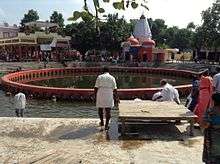 |
Sri Harilakshmi sametha Sri Devaraja Perumal | |
| 67 | Thirupruthi(Jyothirmath) | Jyotirmath, Chamoli district, Uttarakhand 29.92981°N 79.42245°E |
Sri Parimalavalli sametha Sri Paramapurusha Perumal | ||
| 68 | Thirukkandamenum Kadinagar | Devaprayag, Tehri Garhwal district, Uttarakhand 30.145556°N 78.564444°E |
Sri Pundareegavalli sametha Sri Purushottama Perumal | ||
| 69 | Thiruvadari(Badrinath) | Badrinath, Chamoli district, Uttarakhand 30.744695°N 79.491175°E |
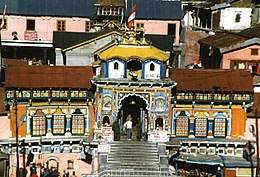 |
Sri Aravindhavalli sametha Sri Badrinarayana Perumal | |
| 70 | Thiru Saligram(Muktinath) | Muktinath Valley Mustang District Nepal 28.816711°N 83.871280°E |
Sri Sridevi sametha Sri Srimurti Perumal | ||
| 71 | Thiruvadamadurai | Mathura, Mathura district, Uttar Pradesh 27.504756°N 77.669646°E |
Sri Satyabama sametha Sri Govardhanagiridhari Perumal | ||
| 72 | Thiruvaipadi | Gokul, Mathura district, Uttar Pradesh 26.95009°N 80.43869°E |
Sri Rukmini Sathyabama sametha Sri Navamohanakrishna Perumal | ||
| 73 | Thirudwarakai(Dwarakadheesh) | Dwarka, Devbhoomi Dwarka district, Gujarat 24.00995°N 73.33053°E |
 |
Sri Rukmini sametha Sri Dwarakadeesha Perumal | |
| 74 | Thirusingavelkundram(Ahobilam) | Ahobilam, Kurnool district, Andhra Pradesh 15.34099°N 79.15329°E |
 |
Sri Amruthavalli sametha Sri Prahlada Varada Perumal | It is at this very place that Lord Narasimha appeared to protect his devotee Prahlada. The giant massive pillar from which he appeared is called Ugra Stambha, and one can still see it. Here, Lord Narasimha appears in nine different forms; these re collectively called Nava Narasimha. |
| 75 | Thiruvenkadam | Tirupati, Chittoor district, Andhra Pradesh 13.83393°N 79.40872°E |
Sri Padmavati sametha Sri Srinivasa Perumal | It is one of the most holy, and most visited temples in India. | |
| 76 | Thirunavai | Tirunavaya, Mallapuram district, Kerala 10.360704°N 76.83654°E |
Sri Malarmangai sametha Sri Navamukunda Perumal | ||
| 77 | Thiruvithuvakodu | Thiruvithuvakoodu, Palakkad district, Kerala 10.36070°N 76.83654°E |
.jpg) |
Sri Vithuvakoduvalli sametha Sri Abhayapradhaya Perumal | |
| 78 | Thrikkakara Vamanamoorthy Kshethram(Thirukatkarai) | Thrikkakara, Ernakulam district, Kerala 10.36070°N 76.83654°E |
 |
Sri Vathsalyavalli sametha Sri Katkaraswami Perumal | |
| 79 | Thirumoozhikkalam | Thirumoozhikulam, Ernakulam district, Kerala 10.36070°N 76.8365°E |
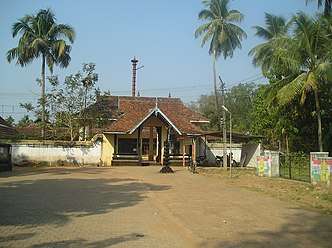 |
Sri Madhuraveni sametha Sri Sookthinatha Perumal | |
| 80 | Sree Vallabha Temple(Thiruvallavazh) | Thiruvalla, Pathanamthitta district, Kerala 9.42723°N 76.81732°E |
Sri Vathsalyavalli sametha Sri Sundaraya Perumal | ||
| 81 | Thrikodithanam Mahavishnu Temple(Thirukkodithanam) | Thrikkodithanam, Changanassery, Kottayam District, Kerala 9.42723°N 76.81732°E |
Sri Karpagavalli sametha Sri Amruthanarayana Perumal | ||
| 82 | Thrichittatt Mahavishnu Temple(Thiruchengundrur) | Chengannur, Alappuzha District, Kerala 9.42723°N 76.81732°E |
Sri Rakthapankajavalli sametha Sri Devathideva Perumal | It is one of the five ancient shrines in the Chengannur area of Kerala, connected with the legend of Mahabharata, where the five Pandavas are believed to have built one temple each; the temple is believed to have been built by Yudhishthira.Imayavar(Devas) came to this place prior to Yudhishthira and hence the deity here is referred as Imayavarappar.[58] There is another version that the Pandavas worshipped the idols during the reign and started installing them in different places during the end of the reign.[59] | |
| 83 | Thiruppuliyur | Thripuliyur, Alappuzha District, Kerala 9.42723°N 76.81732°E |
Sri Porkodi Naachiyaar sametha Sri Maayapiran Perumal | ||
| 84 | Aranmula Parthasarathy Temple(Thiruvaranvilai) | Aranmula, Pathanamthitta District, Kerala 9.35542°N 76.76033°E |
Sri Padmasani Naachiyaar sametha Sri Kuralappan Perumal | ||
| 85 | Thiruvanvandoor | Thiruvanvandoor, Alappuzha District, Kerala 9.35542°N 76.76031°E |
Sri Kamalavalli Naachiyaar sametha Sri Paambanaiyappan Perumal | It is one of the five ancient shrines in the Chengannur area of Kerala, connected with the legend of Mahabharata, where the five Pandavas are believed to have built one temple each; this temple is believed to have been built by Nakula. Earliest references to this temple appear in the poems and hymns composed by the greatest of Alvar saints - Nammalvar, in circa 800 AD. Stone inscriptions in the temple date it back to the Second Chera Empire (800 - 1102 AD).[60] | |
| 86 | Thiruvananthapuram | Thiruvananthapuram, Thiruvananthapuram District, Kerala 8.53402°N 76.92787°E |
 |
Sri Harilakshmi sametha Sri Ananthapadmanabha Perumal | |
| 87 | Thiruvattaru | Thiruvattar, Kanyakumari district, Tamil Nadu 8.36897°N 77.241670°E |
Sri Maragadhavalli sametha Sri Adhikesava Perumal | ||
| 88 | Thiruvanparisaram | Thiruppathisaram, Kanyakumari district, Tamil Nadu8.254153°N 77.47032°E |
 |
Sri Kamalavalli sametha Sri Thiruvazhmarbhan Perumal | |
| 89 | Thirukkurungudi | Thirukkurungudi, Tirunelveli district, Tamil Nadu8.436906°N 77.5259°E |
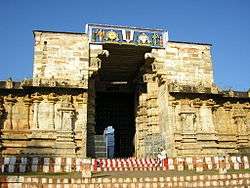 |
Sri Vamanakshetravalli sametha Sri Vamanakshetrapoornaya Perumal | |
| 90 | Thirucheeravaramangai | Nanguneri, Tirunelveli district, Tamil Nadu8.436905°N 77.5259°E |
 |
Sri Chireevaramangaivalli sametha Sri Thothadhrinatha Perumal | |
| 91 | Thiruvaigundam | Srivaikuntam, Thoothukudi district, Tamil Nadu8.609726°N 77.9760°E |
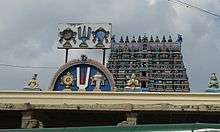 |
Sri Boonayagi, Sri Vaigundavalli sametha Sri Vaikuntanatha Perumal | |
| 92 | Thiruvaragunamangai | Natham, Thoothukudi district, Tamil Nadu8.60972°N 77.976037°E |
 |
Sri Varagunavalli sametha Sri Vijayasana Perumal | |
| 93 | Thiruppuliangudi | Thirupulingudi, Thoothukudi district, Tamil Nadu8.60972°N 77.976037°E |
 |
Sri Malar magal Naachiyaar and Sri Poomagal Naachiyaar sametha Sri Kaaichina Vendhan Perumal | |
| 94 | Thirutholaivillimangalam (Navathirupathi) | Tholavillimangalam, Thoothukudi district, Tamil Nadu8.60972°N 77.97603°E |
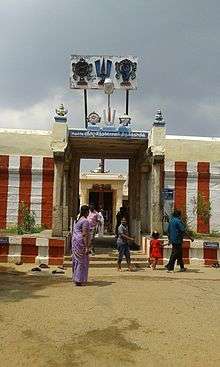 |
Sri Karunthadanganni Naachiyaar sametha Sri Aravindalochana Perumal | |
| 95 | Thirukkulandai (Navathirupathi) | Perungulam, Thoothukudi district, Tamil Nadu8.606968°N 77.950545°E |
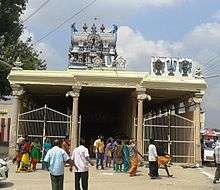 |
Sri Alamelumangai thaayar and Sri Kulandhai Valli sametha Sri Srinivasa Perumal | |
| 96 | Thirukkolur (Navathirupathi) | Thirukolur, Thoothukudi district, Tamil Nadu8.6065018°N 77.97389°E |
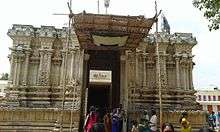 |
Sri Amudhavalli and Sri Koloorvalli sametha Sri Vaitha Maanitha Perumal | |
| 97 | Thirupperai | Thenthiruperai, Thoothukudi district, Tamil Nadu8.60650°N 77.97389°E |
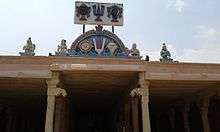 |
Sri Kuzhaikkaadhu Valli, and Sri Thirupperai Naachiyaar sametha Sri Magara NedungKuzhai Kaathar Perumal | |
| 98 | Thirukkurugur | Alwarthirunagari, Thoothukudi district, Tamil Nadu8.60696°N 77.95054°E |
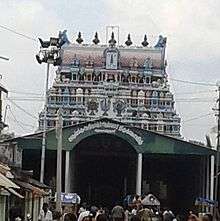 |
Sri Aadhinadha Valli and Sri Gurukoor valli sametha Sri Aadhinatha Perumal | |
| 99 | Thiruvillipputhur | Srivilliputhur, Virudhunagar district, Tamil Nadu8.60696°N 77.95054°E |
 |
Sri Kodhadevi sametha Sri Vatapatrasayee Perumal | |
| 100 | Thiruthangal | Thiruthankal Virudhunagar district, Tamil Nadu9.010702°N 77.8853°E |
 |
Sri Sengamala thaayar sametha Sri Narayana Perumal | The temple in its present form was believed to have been built by Devendra Vallabha, a Pandya king. The temple has three inscriptions in its two rock-cut caves, two dating from the period of 8th century. Ninra Narayana is believed to have appeared to Sridevi and Bhoomadevi. Ranganatha from Srirangam Ranganathaswamy temple was enamoured by the devotion of Andal. He started a journey to Srivilliputhur Divya Desam to seek her hand for marriage. While reaching the place, it became dark and he decided to spend the night in the place. Since he stayed at this place, it came to be known as Thiruthangal and the hillock came to be known as Thalagiri..[61] |
| 101 | Thirukkoodal | Madurai, Madurai district, Tamil Nadu9.98860°N 78.26434°E |
.jpg) |
Sri Madhuravalli sametha Sri Koodal Azhagar Perumal | |
| 102 | Thirumaliruncholai | Alagar Koyil, Madurai district, Tamil Nadu9.988609°N 78.2643428°E |
Sri Sundaravalli sametha Sri Kallazhagar Perumal | Kallazhagar was worshiped by Yama, the Hindu god of death. He requested Vishnu to stay in the place and built a temple with the help of Vishwakarma, the divine architect.[62] Kallazhagar is believed to have appeared to redeem sage Suthapava off his curse from sage Durvasa.[63] The temple houses some rare Vijayanagara sculptures.[64] | |
| 103 | Thirumogur | Thirumohur, Madurai district, Tamil Nadu9.98860°N 78.26434°E |
.jpg) |
Sri Mohavalli sametha Sri Kalamega Perumal | |
| 104 | Thirukkoshtiyur | Thirukoshtiyur, Sivaganga district, Tamil Nadu9.98860°N 78.2643°E |
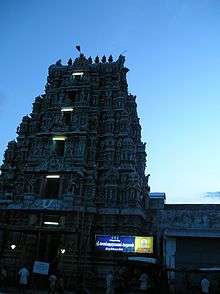 |
Sri Mahalakshmi sametha Sri Uraga Mellanayaan Perumal | The temple is known as the place where Ramanuja, the expounder of Vaishnavadatta philosophy preached the holy syllable "Ohm Namo Narayana" to all people irrespective of their caste. Sowmyanarayana Perumal is believed to have appeared as Narasimha avatar to the Devas, the celestial deities.[65] |
| 105 | Thiruppullani | Thirupullani, Ramanathapuram district, Tamil Nadu9.98860°N 8.26434°E |
 |
Sri Kalyanavalli, Sri Padmasani sametha Sri Kalyana Jagannatha Perumal | |
| 106 | Thirumeyyam | Thirumayam, Pudukottai district, Tamil Nadu9.98860°N 78.2643°E |
 |
Sri Uyya Vandha Naachiyaar sametha Sri Sathyagirinatha Perumal | |
| 107 | Kshira Sagara(Thiruppaarkadal) | Vinnulaga Tirupati | 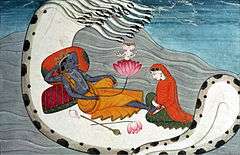 |
Sri Kadal Magal sametha Sri Parkadal Natha Perumal | This Divya Desam is not located on Earth, but in the spiritual realm. |
| 108 | Thirupparamapadham(Vaikunta) | Vinnulaga Tirupati | .jpg) |
Sri Paramapada Nayaki sametha Sri Paramapadha Nathan | This Divya Desam is not located on Earth, but in the spiritual realm. |
See also
Maps
Notes
- P.M., Neelakrishnan (April 1992). "Sri Divya Desams". Ancient Science of Life. Coimbatore: Sarva Sastra Maha Vidyalaya. 11 (3): 193–7. PMC 3336602. PMID 22556587.
- "meaning of Divya Desam".
- R.K.K., Rajarajan (2013). "Historical sequence of the Vaiṣṇava Divyadeśas. Sacred venues of Viṣṇism". Acta Orientalia, Societates Orientales Daniica Fennica Norvegia Svecia. pp. 37–90. ISSN 0001-6438.
- Rao, P.V.L. Narasimha (2008). Kanchipuram – Land of Legends, Saints & Temples. New Delhi: Readworthy Publications (P) Ltd. p. 27. ISBN 978-93-5018-104-1.
- Dalal 2011, pp. 20-21
- R.K.K., Rajarajan (2016). "Master-Slave Ambivalence in the hagiography of the Āḻvārs". The Quarterly Journal of the Mythic Society. 107 (1): 44–60. ISSN 0047-8555.
- Ramaswamy, Vijaya (2007). Historical Dictionary of the Tamils. Scarecrow Press. p. 211. ISBN 9780810864450.
- Iyengar, Ramaseshan (2009). "The Divya Desam Temples: A Premise for Analyzing the Śrivaisnava Dispute in South India" (PDF). George Mason University.
- Mittal, Sushil; Thursby, G. R. (2005). The Hindu World. New York: Routelge. p. 456. ISBN 0-203-67414-6.
- Vater, Tom (2010). Moon Spotlight Angkor Wat. USA: Perseus Books Group. p. 40. ISBN 9781598805611.
- Jones, Victoria (2004). Wonders of the World Dot-to-Dot. New York: Sterling Publishing Co., Inc. p. 4. ISBN 1-4027-1028-3.
- S., Prabhu (27 December 2012). "Unique drama unfolds during procession". The Hindu. Retrieved 9 September 2013.
- "Unique drama unfolds during procession". The Hindu. 8 April 2005. Retrieved 9 September 2013.
- S., Prabhu (6 January 2012). "Ranganatha suffered his pain". The Hindu. Retrieved 21 July 2013.
- T.A., Srinivasan (21 March 2003). "Temple for the Great Trinity". The Hindu. Retrieved 9 September 2013.
- Daniel, Val (1984). Fluid Signs: Being a Person the Tamil Way. University of California Press. pp. 139–140. ISBN 9780520061675.
- Hultzsch, Eugen (1890). South-Indian inscriptions, Volumes 9–10. Superintendent, Gov't press. p. 298.
- "Swastik Well, Tiruvellarai". Department of Archaeology, Government of Tamil Nadu. Retrieved 7 July 2013.
- M., Balaganessin (17 May 2008). "Pallava-built tank plagued by vandalism at Tiruvellarai". The Hindu. Tiruchi. Retrieved 4 March 2013.
- "Hundreds pull temple car". The Hindu. Tiruchi. 9 April 2010. Retrieved 4 March 2013.
- "Devotees pull temple car". The Hindu. Tiruchi. 19 March 2012. Retrieved 4 March 2013.
- "Sri Sundararaja Perumal temple". Dinamalar. Retrieved 9 September 2013.
- Ayyar, P. V. Jagadisa (1982). South Indian Shrines: Illustrated. New Delhi: Asian Educational Services. p. 533. ISBN 9788120601512.
- Jouveau-Dubreuil, Tony (1994). The Pallavas. New Delhi: Asian Educational Services. p. 77. ISBN 81-206-0574-8.
- Jouveau-Dubreuil, G. (1994). Pallava Antiquities – 2 Vols. Asian Educational Services. p. 13. ISBN 978-81-206-0571-8.
- S., Prabhu (16 September 2010). "Restoring the glory of a temple". The Hindu. Retrieved 9 September 2013.
- Soundara Rajan, Kodayanallur Vanamamalai (2001). Concise classified dictionary of Hinduism. New Delhi: Concept Publishing Company. p. 65. ISBN 81-7022-857-3.
- "Temple for the Great Trinity". The Hindu. 11 June 2005. Retrieved 21 February 2016.
- R. 1997, p. 481-2
- T., Padmaja (2002). Temples of Kr̥ṣṇa in South India: history, art, and traditions in Tamilnāḍu. New Delhi: Shakti Malik. pp. 93–94. ISBN 81-7017-398-1.
- M., Rajagopalan (1993). 15 Vaishnava Temples of Tamil Nadu. Chennai, India: Govindaswamy Printers. pp. 57–65.
- Garg, Gaṅgā Rām (1992). Encyclopaedia of the Hindu World: Ak-Aq. Concept Publishing Company. pp. 352–354. ISBN 9788170223757.
- "An NGO does its bit for god - and humanity". New Delhi, India: Hindustan Times. 29 April 2007. Archived from the original on 14 April 2018. Retrieved 13 April 2018 – via HighBeam Research.
- "In a state of neglect". The Hindu. 26 July 2012. Retrieved 10 November 2013.
- Ayyar, P. V. Jagadisa (1982). South Indian Shrines: Illustrated. New Delhi: Asian Educational Services. p. 533. ISBN 9788120601512.
- R., Dr. Vijayalakshmy (2001). An introduction to religion and Philosophy - Tévarám and Tivviyappirapantam (1st ed.). Chennai: International Institute of Tamil Studies. pp. 473–4.
- "Immortalised in stone". The Hindu. 2 July 2009. Retrieved 8 April 2013.
- "Pancharanga Kshetrams". Indiantemples.com. Retrieved 20 June 2007.
- V., Meena (1974). Temples in South India (1st ed.). Kanniyakumari: Harikumar Arts. p. 29.
- "Unique drama unfolds during procession". The Hindu. 8 April 2005. Retrieved 9 September 2013.
- Pillai, Suresh B. (1976). Introduction to the Study of Temple Art. Equator and Meridian. p. 59.
- Dehejia, Vidya (2013). Art of the Imperial Cholas. Columbia University Press. p. 38. ISBN 9780231515245.
- Women in India: A Social and Cultural History [2 volumes]: A Social and Cultural History. ABC-CLIO. 2009. p. 140. ISBN 9780313014406.
- "Sri Jagannatha Perumal temple". Dinamalar. Retrieved 9 September 2013.
- Ayyar, P. V. Jagadisa (1982). South Indian Shrines: Illustrated. New Delhi: Asian Educational Services. p. 534. ISBN 9788120601512.
- Ayyar, P. V. Jagadisa (1982). South Indian Shrines: Illustrated. New Delhi: Asian Educational Services. p. 535. ISBN 9788120601512.
- Thiruvelliyangudi. Thiruvelliyangudi: Temple administration, Sri Kolavalli Ramar Alayam. 2004. p. 1.
- R., Dr. Vijayalakshmy (2001). An introduction to religion and Philosophy - Tévarám and Tivviyappirapantam (1st ed.). Chennai: International Institute of Tamil Studies. pp. 500–1.
- "The Templenet Encyclopedia - Varadaraja Perumal Temple at Kanchipuram".
- Rao 2008, p. 154
- Diwakar, Macherla (2011). Temples of South India (1st ed.). Chennai: Techno Book House. p. 145. ISBN 978-93-83440-34-4.
- C., Chandramouli (2003). Temples of Tamil Nadu Kancheepuram District. Directorate of Census Operations, Tamil Nadu.
- Soundara Rajan, Kodayanallur Vanamamalai (2001). Concise classified dictionary of Hinduism. New Delhi: Concept Publishing Company. p. 38. ISBN 81-7022-857-3.
- Sullivan, Sullivan (1997). Historical Dictionary of Hinduism. England: Scarecro Press INC. p. 126. ISBN 81-250-2800-5.
- "Acme of devotion". Chennai: The Hindu. 14 November 2008. Retrieved 19 October 2014.
- Ayyar, P.V. Jagadisa (1993). South Indian Shrines Illustrated. New Delhi: Asian Educational Services. p. 539. ISBN 81-206-0151-3.
- T.A., Srinivasan (8 December 2000). "Twin temples that draw devotees". The Hindu. Retrieved 29 November 2015.
- Bayi, Gouri Lakshmi (1998). Thulasi garland. Bharatiya Vidya Bhavan. p. 244.
- K., Sukumaran (2009). Theerthayathra: A Pilgrimage Through Various Temples. Bharathiya Vidya Bhavan. ISBN 9788172763633.
- S., Jayashanker (May 1997). Temples of Kerala, page 304-305. Directorate of Census Operations, Kerala (Census of India, Special Studies).
- T.S. Sridhar, ed. (2004). Excavations of Archaeological sites in Tamil Nadu(1969-95) (PDF) (Report). Department of Archaeology, Government of Tamil Nadu, Chennai. p. 6.
- Dalal, Roshan (2010). Hinduism: An Alphabetical Guide. Penguin Books India. p. 18. ISBN 9780143414216.
- "Kallazhagar temple". Dinamalar. 2014. Retrieved 31 May 2014.
- S., Gopalakrishnan (December 1996). "The Raṅga-maṇḍapa of the Tāṭikkompu Temple A Study of an Iconographic Programme of the Vijayanagara Tradition". East and West. 46 (3/4): 415–431. JSTOR 29757285.
- K. V., Soundara Rajan (1967). "The Typology of the Anantaśayī Icon". Artibus Asiae. 29 (1): 80. JSTOR 3250291.
References
- B. S., Chandrababu; S., Ganeshram; C., Bhavani (2011). History of People and Their Environs. Bharathi Puthakalayam. ISBN 9789380325910.
- Chari, S. M. Srinivasa (1997). Philosophy and Theistic Mysticism of the Āl̲vārs. Motilal Banarsidass Publishers. ISBN 9788120813427.
- Dalal, Roshen (2011). Hinduism: An Alphabetical Guide. Penguin Books India. ISBN 9780143414216.
- Das, Sisir Kumar; Sāhitya Akādemī (2005). A history of Indian literature, 500-1399: from courtly to the popular. chennai: Sāhitya Akādemī. ISBN 81-260-2171-3.
- Govindāchārya, Aḷkoṇḍavilli (1902). The Holy Lives of the Azhvârs: Or, the Drâvida Saints. Mysore: G. T. A. Press.
periyazhvar.
- Ramanujan, Attipat Krishnaswami (2005). Hymns for the Drowning: Poems for Vishnu. Penguin Books. ISBN 9780144000104.
- Rao, P.V.L. Narasimha (2008), Kanchipuram - Land of Legends, Saints & Temples, New Delhi: Readworthy Publications (P) Ltd., ISBN 978-93-5018-104-1
External links
| Wikimedia Commons has media related to Divya Desams. |
- www.divyadesam.com
- 108 Divyadesam map
- Divya Prabhandam by Divya Desam
- Compilation of all Pasurams pertaining to each of the 108 Divya desam. Handy as a travel reference guide
- Key Divya Desam details - Thayar, Moolavar, Utsavar, Kolam, Pasuram etc compiled in a neat page/ single table
- "108 Vainava Divyadesa Sthala Varalaru" by 'Vaishnava Sudarazhi' Dr. A. Ethirajan B.A. of Karaikudi, published by the Sri Vaishnava Siddhanta Publications
- Compilation on 108 Divya Desam
- 4000 Divya Prabhandam as one pdf file 2.16 MB
- 4000 Divya Prabhandam free download from Project Tamil
- 4000 Divya Prabhandam from Tamil Virtual University Library
- Divya Desams list at Vedagnana
- R.K.K. Rajarajan (2012) Antiquity of the Vaiṣṇava divyakśētras in Pāṇḍinādu. Acta Orientalia, Societates Orientales Danica Fennica Norvegia Svecia, Vol. 73, pp. 59-104. ISSN 0001-6438